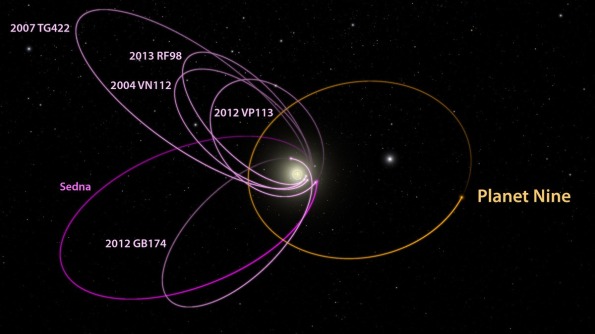Planet 9, or Mike’s Very Elegant Mathematics Just *Suggests* Unverified Ninth Planet
Astronomers at CalTech think they might have found evidence for the existence of a planet in the far reaches of our solar system, which has been nick-named Planet Nine.
The discovery was made by looking at the how such a planet might influence the orbits of smaller dwarf planets and Kuiper belt objects.
Out beyond the orbit of Neptune lies a region of the solar system known as the Kuiper Belt. Think of it as an asteroid belt for icy things. There are a lot of lumps of ice out there, some of them so big that we consider them dwarf planets. In fact one of the largest Kuiper Belt Objects, Pluto, was originally classified as our solar system’s ninth planet when it was discovered in 1930. This status lasted until it was demoted in 2006 by astronomers keen to keep the solar system neat and tidy. Given the discovery of several other Pluto-sized “planets” in the Kuiper belt the decision was made by the International Astronomical Union in 2006 to formally define a planet, and this new definition excluded Pluto and its ilk.
In a curious twist of fate the astronomer who led the charge for Pluto’s demotion in 2006, Mike Brown, was one of the astronomers who announced today the discovery of Planet Nine.
So what is it that has led Mike Brown and his co-author Konstantin Batygin to infer the presence of Planet Nine? If you observe the orbits of six of the most distant Kuiper Belt Objects (KBOs) two similarities emerge.
The first is that they all have elliptical orbits that point in the same direction in space. According to Mike Brown “It’s almost like having six hands on a clock all moving at different rates, and when you happen to look up, they’re all in exactly the same place.” The odds of this happening for these six KBOs is around 1 in 100.
Secondly each of their orbits is inclined by the same amount – about thirty degrees below the plane of the solar system, which is also unlikely to happen by chance.
Combine these two unlikely factors and you find that the probability of these alignments happening by chance is around 0.007% which has led astronomers to speculate about what might be causing these orbital similarities.
Brown and Batygin suggest that a very large planet orbiting in an elliptical path very far from the Sun could be the culprit. The mathematics behind this speculation is all pretty solid. In order to account for what we see in the orbits of the smaller KBOs “Planet 9” would have a mass of around 10 times the size of the Earth, and orbit the Sun at an average distance of around 600 astronomical units, or 90 billion kilometers (30 times further than Neptune).
Crucially no direct observation has been made of Planet 9 so far; its presence has only been inferred, and many astronomers have suggested that if Planet 9 did exist then it would have more observable influence on the KBOs. But rest assured, calculations are being made to try and work out where Planet 9 might sit on its half-a-trillion-kilometre-long orbital path, and we’ll be straining our telescopes to try and work out whether it’s real or not.
Mike Brown is adamant though:
OK, OK, I am now willing to admit: I DO believe that the solar system has nine planets.
— Mike Brown (@plutokiller) January 20, 2016
UPDATE: Last night I came up with this new mnemonic which perfectly encapsulates this latest result:
A new mnemonic for the planets in light of @plutokiller’s #Planet9… Mike’s Very Elegant Mathematics Just Suggests Unverified Ninth Planet
— Steve Owens (@darkskyman) January 21, 2016


Wonder what they’ll call it if it’s confirmed? I like the old name ‘planet x’.
Getting that proof will be the tricky part. And as I pointed out over on my blog, pertubation analysis has been wrong before. Time will tell!